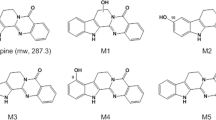Summary
Metabolic pathways of simvastatin (MK-733), a lactone prodrug of an inhibitor of HMG-CoA reductase, were elucidated in male rats, using the [14C]-labelled compound. Evidence has been obtained for hydrolysis of simvastatin and its metabolites at their 2,2-dimethylbutyryl moieties. Metabolites identified in plasma were 2,2-dimethylbutyric acid (DMB), 2,2-dimemyl-3-hydroxybutyric acid (DMHB) and an open chain hydroxy acid of simvastatin: metabolites identified in urine were DMHB, a glucuronide and the glycine conjugate of DMB. They were characterized by gas chromatography/electron impact and chemical ionization mass spectrometry as phenacyl or pertrimethylsilylated derivatives. The structures of the metabolites and the aglycone of the glucuronide were confirmed as phenacyl esters by comparison of their chromatographic data and mass spectra with those of the phenacyl derivatives of authentic compounds.
Similar content being viewed by others
References
Illingworth D.R., Bacon S. (1987): Hypolipidemic effects of HMG-CoA reductase inhibitors in patients with hypercholesterolemia. Am. J. Cardiol., 60, 33G-42G.
Endo A. (1988): Chemistry, biochemistry and pharmacology of HMG-CoA reductase inhibitors. Klin. Wochenschr., 66, 421–427.
Alberts A.W., Chen J., Kuron G., et al. (1980): Mevinolin: a highly potent competitive inhibitor of hydroxymethylglutaryl-coenzyme A reductase and a cholesterol-lowering agent Ptoc. Natl. Acad. Sci. USA, 77, 3957–3961.
Tsujita Y., Kuroda M., Shimada Y., et al. (1986): CS-514, a competitive inhibitor of 3-hydroxy-3-methylglutaryl coenzyme A reductase: tissue-selective inhibition of sterol synthesis and hypolipidemic effect on various animal species. Biochim. Biophys. Acta, 877, 50–60.
Hoffman W.F., Alberts A.W., Anderson P.S., Chen J.S., Smith R.L., Willard A.K. (1986): 3-Hydroxy-3-methylglutaryl-coenzyme A reductase inhibitors. 4. Side chain ester derivatives of mevinolin. J. Med. Chem., 29, 849–852.
Alberts A.W., Chen J., Huff J., Hunt V., Kuron G. (1986): Comparative studies on the hydroxymethyl-glutaryl coenzyme A reductase inhibitors mevinolin, MK-733 and CS-514. Proc. IXth Int Symp. Drugs Affect Lipid Metab., (Florence), 8.
Ishida F., Sato A., Iizuka Y., Sawasaki Y., Aizawa A., Kamei T. (1988): Effects of MK-733, an inhibitor of 3-hydroxy-3-methylglutaryl-coenzyme A reductase, on absorption and excretion of [3H]-cholcsterol in rabbits. Biochim. Biophys. Acta, 963, 35–41.
Kobayashi M., Ishida F., Takahashi T., et al. (1989): Preventive effect of MK-733 (simvastatin), an inhibitor of HMG-CoA reductase, on hypercholesterolemia and atherosclerosis induced by cholesterol feeding in rabbits. Jap. J. Pharmacol., 49, 125–133.
Mol M.J.T.M., Erkelens D.W., Leuven J.A.G., Schouten J.A., Stalenhoef A.F.H. (1986): Effects of synvinolin (MK-733) on plasma lipids in familial hypercholesterolaemia. Lancet, ii, 936–939.
Simons L.A., Nestel P.J., Calvert G.D., Jennings G.L. (1987): Effects of MK-733 on plasma lipid and lipoprotein levels in subjects with hypercholesterolaemia. Med. J. Aust., 147, 65–68.
Walker J.F., Tobert J.A. (1987): The clinical efficacy and safety of lovastatin and MK-733 — an overview. Eur. Heart J., 8, 93–96.
Mol M.J.T.M., Erkelens D.W., Leuven J.A.G., Schouten J.A., Stalenhoef A.F.H. (1988): Simvastatin (MK-733): a potent cholesterol synthesis inhibitor in heterozygous familial hypercholesterolaemia. Atherosclerosis, 69, 131–137.
Mol M.J.T.M., Stuyt P.M.J., Stalenhoef A.F.H. (1989): Effectiviteit veiligheid van simvastatine, een nieuw cholesterolverlagend geneesmiddel. Ned. Tijdschr. Geneeskd., 133, 362–366.
Leclercq V, Harvengt C. (1989): Simvastatin (MK-733) in heterozygous familial hypercholesterolemia: a two-year trial. Int. J. Clin. Pharmacol. Ther. Toxicol., 27, 76–81.
Pietro D.A., Alexander S., Mantell G., Staggers J.E., Cook T.J. (1989): Effects of simvastatin and probucol in hypercholesterolemia (simvastatin multicenter study group II). Am. J. Cardiol., 63, 682–686.
Grundy S.M. (1988): HMG-CoA reductase inhibitors for treatment of hypercholesterolemia. N. Engl. J. Med., 319, 24–33.
Germershausen J.I., Hunt V.M., Bostedor R.G., Bailey P.J., Karkas J.D., Alberts A.W. (1989): Tissue selectivity of the cholesterol-lowering agents lovastatin, simvastatin and pravastatin in rats in vivo. Biochem. Biophys. Res. Commun., 158, 667–675.
Greenspan M.D., Yudkovitz J.B., Alberts A.W., Argenbright L.S., Arison B.H., Smith J.L. (1988): Metabolism of lovastatin by rat and human liver microsomes in vitro. Drug Metab. Dispos., 16, 678–682.
Duggan D.E. (1988): The physiological disposition of lovastatin. Proc. 8th Int. Symp. Atherosclerosis (Rome), 1067.
Vyas K.P. (1988): Metabolism of lovastatin and simvastatin by rat and mouse liver microsomes. Proc. 8th Int. Symp. Atherosclerosis (Rome), 1068.
Duggan D.E., Chen I-W., Bayne W.F., et al. (1989): The physiological disposition of lovastatin. Drug Metab. Dispos., 17, 166–173.
Ohtawa M., Uchiyama N., Saito Y., et al. (1989): Phase I study of MK-733, an inhibitor of HMG-CoA reductase II: pharmacokinetics of MK-733 in healthy subjects after single and multiple oral administration. J. Clin. Ther. Med., 5, 1123–1140.
Clark J.H., Miller J.M. (1977): Hydrogen bonding in organic synthesis V: Potassium fluoride in carboxylic acids as an alternative to crown ether with acid salts in the preparation of phenacyl esters. Tetrahedron Lett., 7, 599–602.
Hendrickson J.B., Kandall C. (1970): The phenacyl protecting group for acids and phenols. Tetrahedron Lett., 5, 343–344.
Kuhara T., Matsumoto I., Ohno M., Ohura T. (1986): Identification and quantification of octanoyl glucuronide in the urine of children who ingested medium-chain triglycerides. Biomed. Environ. Mass Spectrom., 13, 595–598.
Breeman R.B., Stogniew M., Fenselau C. (1988): Characterization of acyl-linked glucuronides by electron impact and fast atom bombardment mass spectrometry. Biomed. Environ. Mass Spectrom., 17, 97–103.
Kuhara T., Hirokata Y., Yamada S., Matsumoto I. (1978): Metabolism of sodium dipropylacetate in human. Eur. J. Drug. Metab., 9, 171–177.
Vickers S., Duncan C.A.H., White S.D., et al. (1985): Carnitine and glucuronic acid conjugates of pivalic acid. Xenobiotica, 15, 453–458.
Author information
Authors and Affiliations
Rights and permissions
About this article
Cite this article
Uchiyama, N., Kagami, Y., Saito, Y. et al. Metabolic fate of 2,2-dimethylbutyryl moiety of simvastatin in rats: Identification of metabolites by gas chromatography/ mass spectrometry. European Journal of Drug Metabolism and Pharmacokinetics 16, 189–196 (1991). https://doi.org/10.1007/BF03189958
Received:
Issue Date:
DOI: https://doi.org/10.1007/BF03189958




